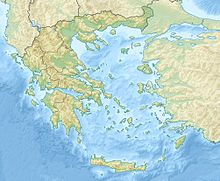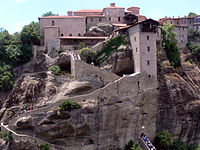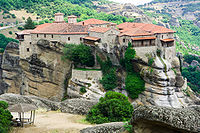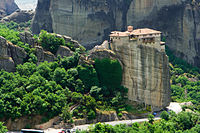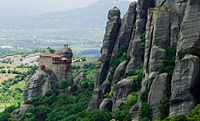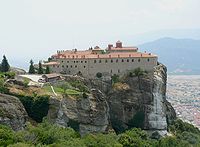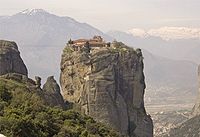- Meteora
-
This article is about the Greek Orthodox monasteries. For the Linkin Park album, see Meteora (album).
Metéora * UNESCO World Heritage SiteCountry Greece Type Mixed Criteria i, ii, iv, v, vii Reference 455 Region ** Europe Coordinates 39°42′N 21°37′E / 39.7°N 21.617°E Inscription history Inscription 1988 (12th Session) * Name as inscribed on World Heritage List
** Region as classified by UNESCO The Katholikon of Holy Trinity Monastery, Meteora.
The Katholikon of Holy Trinity Monastery, Meteora.
The Metéora (Greek: Μετέωρα, "suspended rocks", "suspended in the air" or "in the heavens above" - etymologically similar to "Meteorite") is one of the largest and most important complexes of Eastern Orthodox monasteries in Greece, second only to Mount Athos.[1] The six monasteries are built on natural sandstone rock pillars, at the northwestern edge of the Plain of Thessaly near the Pineios river and Pindus Mountains, in central Greece. The nearest town is Kalambaka. The Metéora is included on the UNESCO World Heritage List under criteria[2] I, II, IV, V and VII.[3]
Contents
History
The Theopetra caves 5 kilometres (3.1 mi) south of Meteora had inhabitants fifty millennia ago. The cave of Theopetra, Kalambaka, radiocarbon evidence for 50,000 years of human presence, Radiocarbon 43(2B): 1029-1048.[citation needed][clarification needed]
In the 9th century, an ascetic group of hermit monks moved up to the ancient pinnacles.
They were the first people to inhabit Metéora. They lived in hollows and fissures in the rock towers, some of which reach 1800 ft (550m) above the plain. This great height, combined with the sheerness of the cliff walls, kept away all but the most determined visitors. Initially the hermits led a life of solitude, meeting only on Sundays and special days to worship and pray in a chapel built at the foot of a rock known as Dhoupiani. As early as the 11th century AD hermit monks were believed to be living among the caves and cutouts in the rocks.[1]
The exact date of the establishment of the monasteries is unknown. By the late 11th and early 12th century, a rudimentary monastic state had formed called the Skete of Stagoi and was centered around the still-standing church of Theotokos (mother of God).[1] By the end of the 12th century, an ascetic community had flocked to Metéora.
In 1344, Athanasios Koinovitis from Mount Athos brought a group of followers to Metéora. From 1356 to 1372, he founded the great Meteoron monastery on Broad Rock, which were perfect for the monks; they were safe from political upheaval and had complete control of the entry to the monastery. The only means of reaching it was by climbing a long ladder, which was drawn up whenever the monks felt threatened.
At the end of the 14th century, the Byzantine Empire's 800-year reign over northern Greece was being increasingly threatened by Turkish raiders who wanted control over the fertile plain of Thessaly. The hermit monks, seeking a retreat from the expanding Turkish occupation, found the inaccessible rock pillars of Meteora to be an ideal refuge. More than 20 monasteries were built, beginning in the 14th century.[1] Six remain today. There is a common belief that St. Athanasius (founder of the first monastery) did not scale the rock, but was carried there by an eagle.[4]
In 1517, Nectarios and Theophanes built the monastery of Varlaám, which was reputed to house the finger of St John and the shoulder blade of St Andrew.
Access to the monasteries was originally (and deliberately) difficult, requiring either long ladders lashed together or large nets used to haul up both goods and people. This required quite a leap of faith – the ropes were replaced, so the story goes, only "when the Lord let them break".[5] In the words of UNESCO, "The net in which intrepid pilgrims were hoisted up vertically alongside the 373 metres (1,224 ft) cliff where the Varlaam monastery dominates the valley symbolizes the fragility of a traditional way of life that is threatened with extinction."[6] In the 1920s there was an improvement in the arrangements. Steps were cut into the rock, making the complex accessible via a bridge from the nearby plateau. During World War II the site was bombed and many art treasures were stolen.
Until the 17th century, the primary means of conveying goods and people from these eyries was by means of baskets and ropes.[7]
Only six of the monasteries remain today.[6] Of these six, four were inhabited by men, and two by women. Each monastery has fewer than 10 inhabitants. The monasteries are now tourist attractions.
Geography
Average elevation is 313 metres (1,027 ft).[8]
Geology
Studies suggest that the pinnacles were formed about 60 million years ago during the Tertiary Period.[9] Weathering and earthquakes then shaped them into their present shape.
Beside the Pindos Mountains, at the western region of the Thessaly plain in the middle of northern Greece, these sandstone rocks rise from the ground. The rocks are composed of a mixture of sandstone and conglomerate. They were formed about 60 million years ago. A series of earth movements pushed the seabed upwards, creating a high plateau and causing many fault lines to appear in the thick layer of sandstone.
Continuous weathering by water, wind and extremes of temperature turned them into huge rock pillars, marked by horizontal lines which geologists maintain were made by the waters of a prehistoric sea. Greek historian Herodotus wrote in the 5th century BC that local people believed the plain of Thessaly had once been a sea. If this was accurate, there was most probably an inundation at the end of the last Ice Age, around 8000 BC. However, he failed to mention the rocks of Metéora, and nor are they recorded in the writings of other ancient Greek authors. This has led to the belief that the pinnacles did not exist 2000 years ago; a theory dismissed by modern geologists.
The cave of Theopetra is located at the foot of the cliffs. Excavations and research and have discovered petrified diatoms, which have contributed to understanding the Palaeo-climate and climate changes. Radiocarbon data evidences human presence dating back 50,000 years.[citation needed] The cave is closed to the public.
Climate
The climate in the region varies greatly according to the time of year. It may be sweltering during summertime, but extremely cold in wintertime. Rainfall is generally heavy all year round, especially at higher altitudes, but the driest time of the year is during summer.[9]
List of Monasteries
All of these monasteries are located at Metéora in Greece, and most are perched on high cliffs and accessible by staircases cut into the rock formations. They were created to serve monks and nuns following the teachings of the Greek Orthodox Church. Much of the architecture of these buildings is Athonite[10] in origin. Of the six intact monasteries, the Holy Monastery of St. Stephen and Monastery Roussanou are inhabited by nuns.
Monastery Photograph The Holy Monastery of Great Meteoron - This is the largest of the monasteries located at Metéora. It was erected in the mid-14th century AD and was the subject of restoration and embellishment projects in 1483 and 1552. The building serves as the main museum for tourists. The Katholikon (main church), consecrated in honour of the Transfiguration of Jesus was erected in the middle of 14th c. and 1387/88 and decorated in 1483 and 1552.[11] The Holy Monastery of Varlaam – The Holy Monastery of Varlaam is the second largest monastery in the Metéora complex. It was built in 1541 and embellished in 1548. A church, dedicated to All Saints, is in the Athonite type (cross-in-square with dome and choirs), with spacious esonarthex (lite) is surrounded by a dome. It was built in 1541/42 and decorated in 1548, while the esonarthex was decorated in 1566. The old refectory is used as a museum while north of the church is the parekklesion of the Three Bishops, built in 1627 and decorated in 1637.[12] The Holy Monastery of Rousanou/St. Barbara[13] was founded in the middle of 16th century AD and decorated in 1560. The Holy Monastery of St. Nicholas Anapausas, built in the 16th century AD, is a small church. It was decorated by the Cretan painter Theophanis Strelitzas, in 1527. The Holy Monastery of St. Stephen is a small church built in the 16th century and decorated in 1545. This monastery rests on the plain rather than on a cliff. It was damaged by the Nazis during WWII who believed it was harboring insurgents and was abandoned. Nuns took it over and reconstructed it.[14] The Monastery of the Holy Trinity is on top of the cliffs. It was built in 1475 and was remodeled many times in 1684, 1689, 1692, 1741.
Literature, music and film inspired by Meteora
- The monastery of Holy Trinity was a filming location in the 1981 James Bond movie For Your Eyes Only[15]
- Scenes from Tintin and the Golden Fleece were also shot at the Meteora monasteries.
- The rock area was a primary inspiration behind the Linkin Park album of the same name.
- Francesco's Mediterranean Voyage is a BBC Television documentary series first aired in 2008
- Michina, the main setting of the movie Pokémon: Arceus and the Jewel of Life is based on Meteora.
- Meteora is the main location in the fiction book The Spook's Sacrifice, by Lancashire author Joseph Delaney
- In the post-apocalyptic horror novel World War Z, the monasteries' natural protection is restored to protect survivors from growing zombie hordes.[16]
Gallery
Sources
- Reader's Digest. Strange Worlds Amazing Places (1994), 432 pp. Published: Reader's Digest Association Limited, London. ISBN 0 276-42111 6
Notes
- ^ a b c d Sofianos, D.Z.: "Metéora". Holy Monastery of Great Meteoro, 1991.
- ^ http://whc.unesco.org/en/criteria/ retrieved November 7, 2007
- ^ http://whc.unesco.org/en/list/455/documents/ retrieved November 2, 2007
- ^ http://www.frommers.com/destinations/themeteora/1665010001.html retrieved March 20
- ^ http://travelwithachallenge.com/Greece-Meteora.htm retrieved November 9, 2007
- ^ a b http://www.sacred-destinations.com/greece/meteora-monasteries.htm retrieved November 3, 2007
- ^ http://www.newsfinder.org/site/more/meteora_connecting_with_heaven/ retrieved September 11, 2007
- ^ [1]
- ^ a b Meteora - Greece
- ^ Referring to Mount Athos
- ^ http://www.meteora-greece.com/greatmeteoron.htm retrieved November 2, 2007
- ^ http://www.kalampaka.com/en/meteora/monasteries.asp retrieved May 22, 2009
- ^ Meteora - Greece
- ^ http://pr.tennessee.edu/alumnus/fall95/greece.html retrieved September 11, 2007
- ^ Internet Movie DataBase
- ^ Google Book page from World War Z
External links
- A local site with information on the monasteries and area.
- Meteora photo gallery by Andy Carvin, March 2001.
- Suspended in the air | Meteora Timelapse video of Meteora
World Heritage Sites in Greece North Aigai · Mount Athos · Paleochristian and Byzantine Monuments of Thessalonica: (Hagios Demetrios, Arch and Tomb of Galerius, Hagia Sophia, Church of Panagia Chalkeon, Church of Saint Nicholas Orphanos, Church of the Holy Apostles, Church of the Acheiropoietos, Monastery of Latomos, Church of Saint Panteleimon)
Central Delphi · Epidaurus · Hosios Loukas · Meteora · Mycenae and Tiryns · Mystras · Old Town of Corfu · Olympia · Temple of Apollo Epicurius at Bassae
Attica Aegean Islands
and CreteCoordinates: 39°42′51″N 21°37′52″E / 39.71417°N 21.63111°E
Categories:
Wikimedia Foundation. 2010.


